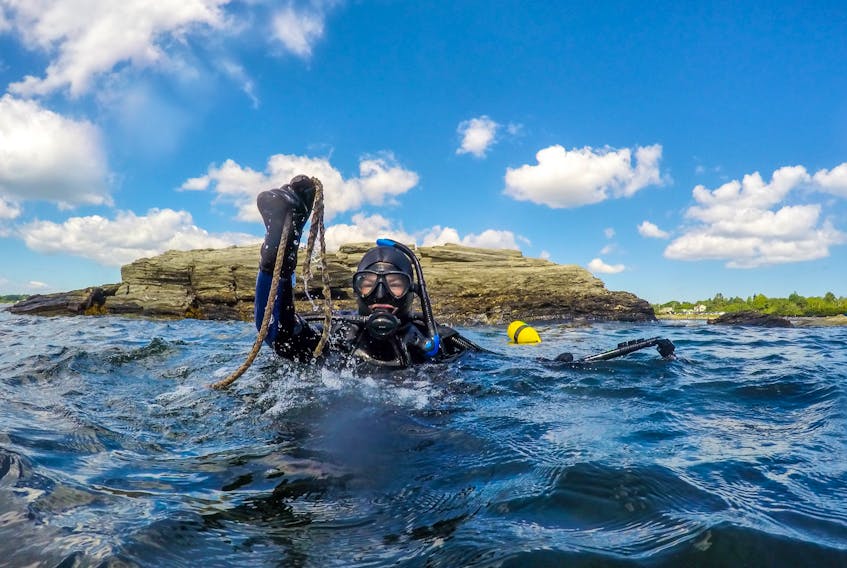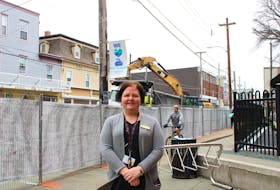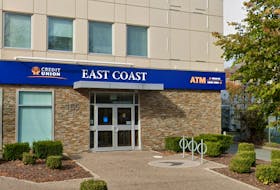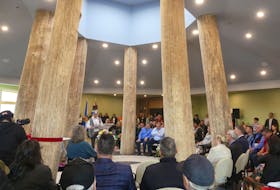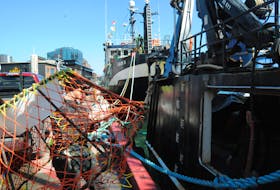It’s the seafaring version of ghost busters.
The mission is to hunt down and exterminate lost fishing gear in Canadian waters.
Over the next two years, and with funding from the Department of Fisheries and Oceans, organizations from Atlantic Canada, as well as the Pacific coast, will go fishing for lost ropes, nets and shellfish traps, and recycle or dispose of the the items they find.
Earlier this month the federal government announced $8 million for a Sustainable Fisheries Solutions and Retrieval Support Contribution Program — ‘ghost gear’ — for 22 projects in Canada, including three internationally.
Ten of those projects are in Atlantic Canada, with funding of $3 million over the next two years. One of the organizations involved is the Coastal Action group based in southwest Nova Scotia.
With close to half $1 million in funding the group will aim to track down and retrieve lost lobster pots and other fishing gear in lobster fishing areas 33, 34 and 35.
Alexa Goodman is project leader for Coastal Action. She told Saltwire the funding will allow the group to hire seven fishing vessels to trawl the waters within 10 nautical miles of shore, in three lobster fishing zones in the region.
They plan to have 159 days at sea over the course of the two years.
“The first year will have 90 days of sea time,” Goodman said, “and in the second year of the project we’ll have 69 days of sea time.”
The days at sea will be determined by weather and regular fishing schedules.
“Retrieval has to happen outside of the actual fishing season,” Goodman said.
Other groups will be involved with the work in southern Nova Scotia. Coastal Action will be coordinating with the Ocean Tracking Network, and using side scan sonars to locate some of the lost gear. The focus is on lobster traps that are lying on the bottom, but they’ll be on the lookout for nets, ropes and other residue that doesn’t belong in the ocean.
Some of the gear collected may be returned to its owners, if the tags of ownership are still fixed to things like lobster traps. They’ll also set up 10 rope recyling bins at harbours in the area, to provide a place for fishers to dispose of that material.
Rope can be recycled, Goodman said, and it could even end up as a biofuel.
In the coming week Goodman will be meeting with fisherman from Nova Scotia’s South West coast to explain some of the details of the program and to find the fishermen who would be willing to take their boats to sea for a few days to help collect the ghost gear.

Meanwhile in Petty Harbour, Newfoundland and Labrador, the local fishermen’s co-operative already has people putting up their hand to participate in the at-sea work.
They’ll need 12 boats, said Bill Lee, president of the Petty Harbour Fishermen’s Co-operative.
Lee said they’ll narrow it down to 12 with a selection process that assesses each boat and whether it’s equipped to do the job. If it ends up that more than 12 meet the criteria, they may simply resort to putting the names in a hat for a draw. Once the program begins each of the 12 boats will spend five days at sea.
“We’ve got grids to search, from Cape Pine to Cape St. Francis,” he explained. “Two boats will each search a grid patter of 25 square miles,” he said. “We’ll zone in on areas that were tradtional fishing areas,” he added, since that’s the most likely place to find lost gear.
“Once we get those hotspots covered will do random searches to find any other gear that might be out there. “
The fishermen’s co-op is getting $381,000 from the Ghost Gear fund as part of the two-year program.
“It is one of the deadliest form of plastic debris and pose a serious dangerous to marine animals like whales and turtles, the coastal and marine environment, and global fishing stocks.”
Over at the office of the Fish Food and Allied Workers (FFAW) on Hamilton Avenue in St. Johns, they’re also gearing up to start marine hunting and gathering mission. The union that represents most fish harvesters in Newfoundland and labrador is getting just over $650,000 in funding through the program.
Their search area is a large one.
FFAW president Keith Sullivan said they will be searching for lost gear in all of the NAFO (Northest Atlantic Fisheries Organization) fishing zones around the province, from 2J on the coast of Labrador to 3PS on the south coast.
It’s an expansive area. And certainly not every inch of ocean can be covered
“We’re going to look at two vessels working in tandem at one time in each zone,” said Sullivan.
The searches will zone in on the hotspots, areas where fishing activity usually occurs. Right now the FFAW is working on a plan to find fishing vessels to participate in this program. The aim is to have boats out looking for lost gear by the end of this summer.
In its announcement earlier this month the DFO said lost and abandoned fishing gear “is one of the largest contributors to marine litter around the world.
“It is one of the deadliest form of plastic debris and pose a serious dangerous to marine animals like whales and turtles, the coastal and marine environment, and global fishing stocks.”
Fisheries and Oceans minister Bernadette Jordan, in the press release, is quoted as saying, “Fighting plastic pollution is a priority for our government. We can’t have a healthy ocean or a strong blue economy if our waters are severely polluted by plastic.”
A media spokesperson for DFO said while the department has worked on retrieval of ghost fishing gear in the past, such as Operation Ghost in July 2019, this is the first program providing funding to other parties to remove ghost gear.
The spokesperson added that for the duration of the two-year program, the DFO will provide regular updates and communications on the status of all projects funded.
“After all projects are completed in 2022 a final report on the Ghost Gear funded projects, including results, will be published.”
The Atlantic projects
NEW BRUNSWICK
FUNDY NORTH
LOCATION: ST. ANDREWS, NB
This project aims to build recycling capacity to manage end-of-life lobster traps in southwestern New Brunswick.
MALISEET NATION CONSERVATION COUNCIL
LOCATION: BAY OF FUNDY, NB
This project will focus on using SCUBA and surface-supply diving as an effective ghost-gear recovery method in the Bay of Fundy. The group will work with COJO Diving and the Marine Debris Strategic Action Committee to develop safe and effective methods for removing ghost gear.
NOVA SCOTIA
CAPE BRETON FISH HARVESTERS ASSOCIATION
LOCATION: CAPE BRETON, NS
This is a one-year project focused on the removal of abandoned, lost and discarded gear in the areas that have been highlighted as a concern by local fish harvesters in Lobster Fishing Area 27.
COASTAL ACTION
LOCATION: SOUTH SHORE, NS
This project will work with industry, academia, and government to prevent, reduce, and assess impacts of ghost gear on the South Shore of Nova Scotia (Lobster Fishing Areas 33, 34, and 35 – Nova Scotia only) from July 2020 to March 2022.
The project will also involve awareness campaigns for the duration of the work.
CSR GEOSURVEYS LTD.
LOCATION: BAY OF FUNDY, NS
CSR GeoSurveys Ltd., an industry leader in the field of ocean mapping, will focus on the identification, retrieval and disposal of ghost fishing gear from challenging areas within the Bay of Fundy, specifically in Lobster fishing areas 36-38.
CSR GEOSURVEYS LTD.
LOCATION: NORTHUMBERLAND STRAIT
CSR GeoSurveys Ltd. will carry out a project in Lobster Fishing Area 26A, similiar to the project in the Bay of Fundy.
EASTERN NOVA SCOTIA MARINE STEWARDSHIP SOCIETY
LOCATION: LOUISBOURG, NS
This project will include pilot studies of GPS-enabled smart buoy technology in the Maritimes, assessing its applicability in the fisheries and other industries. Three fixed-gear wild-catch fisheries in the Maritimes have been identified as candidates for piloting the technology: lobster, snow crab, and whelk. In addition, the technology will also be used to track gear at mussel and scallop aquaculture operations.
NEWFOUNDLAND
FISH, FOOD, AND ALLIED WORKERS UNION (FFAW-UNIFOR)
LOCATION: ST. JOHN’S, NL
The FFAW will be lead a harvester-driven initiative to recover ghost gear across Newfoundland and Labrador. As a result of this project, FFAW-Unifor will develop training and educational material on gear retrieval best practices for the future.
PETTY HARBOUR FISHERMAN’S COOPERATIVE
LOCATION: PETTY HARBOUR, NL
Using multiple vessels equipped with chart plotters, this project will involve a grid search of the area from Cape St. Francis to Cape Pine, for a distance of eight km out to sea.
All debris will be landed and stored at our facility in Petty Harbour until it is disposed of.
NATIONAL
FISHING GEAR COALITION OF ATLANTIC CANADA
LOCATION: DARTMOUTH, NS
PROJECT DESCRIPTION
Since forming in November 2018, the Fishing Gear Coalition of Atlantic Canada (FGCAC) has been working collaboratively on preventing and recovering end-of-life abandoned, lost, and discarded fishing and aquaculture gear and developing sustainable solutions to retrieve and recycle these materials. Building on this work, our project team, in partnership with Cleanfarms, will collaborate with key stakeholders and rights holders to implement a self-sustaining product stewardship program for end-of-life fishing gear across Eastern Canada.
Source: Department of Fisheries and Oceans

